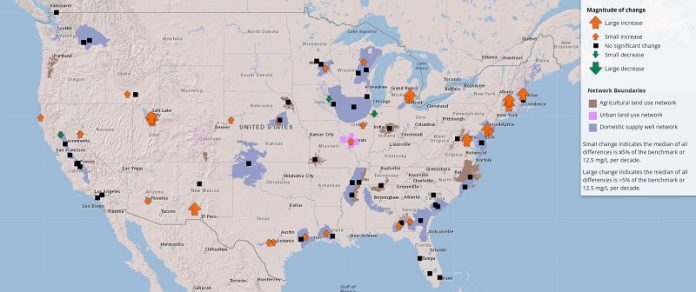
Our groundwater is becoming saltier, and this might be a problem we didn’t see coming.
Scientists from the U.S. Geological Survey (USGS) have been on a mission, looking at our groundwater for over 30 years to see if anything harmful is mixed in.
They’ve been checking for lots of different chemicals and substances.
Here’s what they found: There’s an increase in salt-related stuff, like sodium (Na) and chloride (Cl) ions, in our groundwater. They’ll be talking more about this at a big meeting of geologists.
This study isn’t new; it started in 1992. Bruce Lindsey from USGS says they wanted to check the health of our nation’s waters – from underground water to rivers and lakes.
As they kept studying, they zeroed in on certain substances that might cause lasting harm.
They took water samples from wells in different places: homes, cities, and farms. Wells in our homes, which aren’t strictly watched by the government, gave them clues about the water we drink. The wells in cities and farms were shallower, showing them what’s happening just below the ground.
Lindsey said these shallow wells are like an early warning system. They show what might sink deeper into our main water sources in the future.
In their study, the scientists chose 82 areas, each with multiple wells. They decided to closely watch 28 substances that could be of concern.
Every 10 years, they checked these substances in the water. If you’re curious about their findings, USGS even has an online map where you can see the changes over the decades.
Here’s the surprising part: Among the 28 substances they were watching, dissolved solids, chloride, and sodium increased the most.
When looking at the map, Lindsey points out that some areas, especially in the Northeast and Upper Midwest near cities, have this problem because of road salt used during snowy seasons. They even checked how much road salt was used and found a link between more road salt and increased saltiness in groundwater.
Another area of concern is the dry parts of the country, like the southwest. These places already have salty soil. But when they water their crops, a lot of water evaporates, leaving behind even saltier soil.
So, why should we care? First, many of our rivers and streams get their water from the ground. If that water has too much salt, it can hurt the plants and animals living in the water. Lindsey warns that it might take decades for things to get back to normal if we start managing our salt use better now.
Next, salty water can damage our man-made structures. It can make the water more corrosive. This means the water can eat away at our pipes, especially if they are made of metals like lead.
But there’s more: In New Jersey, they found a rare but serious problem. The mix of acidic water and the increased salt in the groundwater has caused radium (a harmful radioactive element) to get into the water. Lindsey explained that this is again linked to road salt. As we use more of it, it’s causing not just saltiness to increase but also harmful radium.
Some good news? People are becoming more aware of how road salt affects the environment. Some are using less salt, and others are using a watery salt mixture that’s not as strong.
Dead plants near roadsides show where there’s too much salt. But Lindsey hopes that their findings will show the bigger picture: that salt can harm our waterways, our pipes, and even increase harmful substances like radium.
In short, while salting our roads in winter helps us drive safely, we need to understand and address the hidden consequences it might have on our groundwater and environment.
Follow us on Twitter for more articles about this topic.



